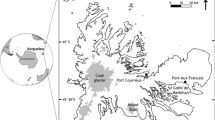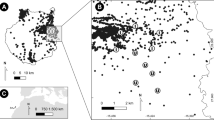Abstract
Invasive predators may change their own trophic conditions by progressively displacing or reducing diversity and abundance of native prey. As food quality and quantity are two main factors determining adult body size in arthropods, alteration of the available resources may thus affect predators’ morphology. The flightless carabid beetle Merizodus soledadinus was accidentally introduced to Iles Kerguelen in a single site in 1913. Its successful spreading process has been monitored over the long term, providing an exceptional research opportunity with multiple snapshots of similar colonized sites mostly differing by the residence time of M. soledadinus. To test if M. soledadinus’ morphology is correlated with its residence time in each habitat, we measured nine morphometric traits in five populations. We detected significant morphological differences: individuals from the first colonized site were the smallest, whereas individuals from the most recently colonized site were the largest. Our study also highlighted among-site variation in sexual dimorphism of the last abdominal sternite: its length differed between sites for females, but not for males. We discuss this diminution of M. soledadinus’ size in the light of both a priori (development under diet restriction, survival) and a posteriori (intrapopulation competition, cannibalism) effects on growth and development.







Similar content being viewed by others
References
Angilletta MJ (2009) Thermal adaptation: a theoretical and empirical synthesis. Oxford University Press, Oxford
Angilletta J, Dunham AE (2003) The temperature-size rule in ectotherms: simple evolutionary explanations may not be general. Am Nat 162:332–342
Arthur AL, Weeks AR, Sgrò CM (2008) Investigating latitudinal clines for life history and stress resistance traits in Drosophila simulans from eastern Australia. J Evol Biol 21:1470–1479
Atchley WR (1971) A comparative study of the causes and significance of morphological variation in adults and pupae of Culicoides: a factor analysis and multiple regression study. Evolution 25:563–583
Badyaev AV (2002) Growing apart: an ontogenetic perspective on the evolution of sexual size dimorphism. Trends Ecol Evol 17:369–378
Berven KA, Gill DE (1983) Interpreting geographic variation in life-history traits. Integr Comp Biol 23:85–97
Blake S, Foster GN, Eyre MD, Luff ML (1994) Effects of habitat type and grassland management practices on the body size distribution of carabid beetles. Pedobiologia 38:502–512
Blanckenhorn WU (1998) Adaptive phenotypic plasticity in growth, development, and body size in the yellow dung fly. Evolution 52:1394–1407
Blanckenhorn WU (2000) The evolution of body size: what keeps organisms small? Q Rev Biol 75:385–487
Blanckenhorn WU, Demont M (2004) Bergmann and converse Bergmann latitudinal clines in arthropods: two ends of a continuum? Integr Comp Biol 44:413–424
Blanckenhorn WU, Stillwell CR, Young KA, Fox CW, Ashtons KG (2006) When Rensch meets Bergmann: does sexual size dimorphism change systematically with latitude? Evolution 60:2004–2011
Boggs CL, Freeman KD (2005) Larval food limitation in butterflies: effects on adult resource allocation and fitness. Oecologia 144:353–361
Bommarco R (1998) Reproduction and energy reserves of a predatory carabid beetle relative to agroecosystem complexity. Ecol Appl 8:846–853
Butler MG (1986) Life history of aquatic insects. In: Resh VH, Rosenberg DM (eds) The ecology of aquatic insects. Praeger, New York, pp 24–35
Cabanita R, Atkinson D (2006) Seasonal time constraints do not explain exceptions to the temperature size rule in ectotherms. Oikos 114:431–440
Chevrier M (1996) Introduction de deux espèces d’insectes aux Îles Kerguelen: processus de colonisation et exemples d’interactions. Ph.D thesis, Université de Rennes 1, France, p 187
Chevrier M, Vernon P, Frenot Y (1997) Potential effects of two alien insects on a subantarctic wingless fly in the Kerguelen Islands. In: Battaglia B, Valencia J, Walton DWH (eds) Antarctic communities: species, structure and survival. Cambridge University Press, Cambridge, pp 424–431
Chown SL, Klok CJ (2003) Altitudinal body size clines: latitudinal effects associated with changing seasonality. Ecography 26:445–455
Chown SL, Nicholson SW (2004) Letal temperatura limits. In: Chown SL, Nicholson SW (eds) Insect physiological ecology: mechanisms and patterns. Oxford University Press, Oxford, pp 115–153
Chown SL, Slabber S, McGeoch MA, Janion C, Leinaas HP (2007) Phenotypic plasticity mediates climate change responses among invasive and indigenous arthropods. Proc R Soc B 274:2531–2537
Currie CR, Spence JR, Niemelä J (1996) Competition, cannibalism and intraguild predation among ground beetles (Coleoptera:Carabidae): a laboratory study. Coleopts Bull 50:135–148
Day KE, Kirby RS, Reynoldson TB (1994) Sexual dimorphism in Chironomus riparius (Meigen): impact on interpretation of growth in whole-sediment toxicity tests. Environ Toxicol Chem 13:35–39
den Nijs LJMF, Lock CAM, Noorlander J, Booij CJH (1996) Search for quality parameters to estimate the condition of Pterostichus cupreus (Col., Carabidae) in view of population dynamic modelling. J Appl Entomol 120:147–151
Dong Q, Polis GA (1992) The dynamics of cannibalistic populations: a foraging perspective. In: Elgar MA, Crespi BJ (eds) Cannibalism: ecology and evolution among diverse taxa. Oxford Scientific Publications, Oxford, pp 13–37
Dongen SV (2006) Fluctuating asymmetry and developmental instability in evolutionary biology: past, present and future. J Evol Biol 19:552–563
Eberhard WG (1998) Sexual behavior of Acanthocephala declivis guatemalana (Hemiptera:Coreidae) and the allometric scaling of their modified hind legs. Ann Entomol Soc Am 91:863–871
Ernsting G (1993) Observations on life cycle and feeding ecology of two recently introduced predatory beetle species at South Georgia, sub-Antarctic. Polar Biol 13:423–428
Fairbairn DJ (1997) Allometry for sexual size dimorphism: pattern and process in the coevolution of body size in males and females. Annu Rev Ecol Syst 28:659–687
Garnier S, Magniez-Janin F, Rasplus JY, Alibert P (2005) When morphometry meets genetics: inferring the phylogeography of Carabus solieri using Fourier analyses of pronotum and male genitalia. J Evol Biol 18:269–280
Gray JS (1989) Effects of environmental stress on species rich assemblages. Biol J Linn Soc 37:19–32
Gruner DS (2003) Regressions of length and width to predict arthropod biomass in the Hawaiian Islands. Pac Sci 57:325–336
Hallas R, Schiffer M, Hoffmann AA (2002) Clinal variation in Drosophila serrata for stress resistance and body size. Genet Res 79:141–148
Hodar JA (1996) The use of regression equations for estimation of arthropod biomass in ecological studies. Acta Oecol 17:421–433
Jarosik V (1989) Mass vs. length relationship for carabid beetles (Col., Carabidae). Pedobiologia 33:87–90
Jeannel R (1940) Croisière du Bougainville aux îles australes françaises. III. Coléoptères. Mem du Museum National d’Histoire Naturelle, France, Sér A 14:63–202
Juliano SA (1985) The effects of body size on mating and reproduction in Brachinus lateralis (Coleoptera: Carabidae). Ecol Entomol 10:271–280
Juliano SA (1986) Food limitation of reproduction and survival for population of Brachinus (Coleoptera:Carabidae). Ecology 67:1036–1045
Karino K, Seki N, Chiba M (2004) Larval nutritional environment determines adult size in Japanese horned beetles Allomyrina dichotoma. Ecol Res 19:663–668
Kenis M, Auger-Rozenberg MA, Roques A, Timms L, Péré C, Cock MJW, Settele J, Augustin S, Lopez-Vaamonde C (2008) Ecological effects of invasive alien insects. Biol Invasions 11:21–45
Krebs JR, Davies NB (1993) An introduction to behavioural ecology. Blackwell Scientific Publications, Oxford, 432 p
Lenski RE (1982) The impact of forest cutting on the diversity of ground beetles (Coleoptera:Carabidae) in the southern Appalachians. Ecol Entomol 7:385–390
Magura T, Tóthmérész B, Lövei GL (2006) Body size inequality of carabids along an urbanisation gradient. Basic Appl Ecol 7:472–482
McGeoch MA (1998) The selection, testing and application of terrestrial insects as bioindicators. Biol Rev 73:181–201
Moczek AP (1998) Horn polyphenism in the beetle Onthophagus taurus: larval diet quality and plasticity in parental investment determine adult body size and male horn morphology. Behav Ecol 9:636–641
Nice CC, Shapiro AM (1999) Molecular and morphological divergence in the butterfly genus Lycaeides (Leipdoptera: Lycaenidae) in North America: evidence of recent speciation. J Evol Biol 12:936–950
Nijhout HF, Davidowitz G (2003) Developmental perspectives on phenotypic variation: canalization, and fluctuating asymmetry. In: Polak M (ed) Developmental instability: causes and consequences. Oxford University Press, Oxford, pp 3–13
Nylin S, Gotthard K (1998) Plasticity in life-history traits. Ann Rev Entomol 43:63–83
Pearson DL, Knisley CB (1985) Evidence for food as limiting resource in the life cycle of tiger beetles (Coleoptera:Cicindelidae). Oikos 45:161–168
Pearson DL, Stemberger SL (1980) Competition, body size and the relative energy balance of adult tiger beetles (Coleoptera:Cicindelidae). Am Midl Nat 104:373–377
Peters RH (1983) The ecological implications of body size. Cambridge University Press, Cambridge
Preziosi RF, Fairbairn DJ (1996) Sexual size dimorphism and selection in the wild in the waterstrider Aquarius remigis: Body size, components of body size and male mating success. J Evol Biol 9:317–336
Renault D, Hance T, Vannier G, Vernon P (2003) Is body size an influential parameter in determining the duration of survival at low temperatures in Alphitobius diaperinus Panzer (Coleoptera: Tenebrionidae)? J Zool 259:381–388
Rosecchi E, Thomas F, Crivelli AJ (2001) Can life-history traits predict the fate of introduced species? A case study of two cyprinid fish in southern France. Freshw Biol 46:845–853
Schmidt-Nielsen K (1984) Scaling: why is body size so important? Cambridge University Press, Cambridge, 241 p
Shingleton AW, Frankino WA, Flatt T, Nijhout HF, Emlen DJ (2007) Size and shape: the developmental regulation of static allometry in insects. Bioessays 29:536–548
Snyder W, Evans E (2006) Ecological effects of invasive arthropod generalist predators. Annu Rev Ecol Syst 37:95–122
Sota T (1985) Limitation of reproduction by feeding condition in a carabid beetle, Carabus yaconinus. Res Popul Ecol 27:171–184
Stern DL, Emlen DJ (1999) The developmental basis for allometry in insects. Development 126:1091–1101
Stern DL, Moon A, Martinez del Rio C (1996) Caste allometries in the soldier-producing aphid Pseudoregma alexanderi (Hormaphididae: Aphidoidea). Insectes Soc 43:137–147
Svensson B (1977) Life history, energy fluctuations, and sexual differentiation in Ephemera danica (Ephemeroptera), a stream-living mayfly. Oikos 29:78–86
Szyszko J (1983) State of Carabidae (Col.) fauna in fresh pine forest and tentative valorisation of this environment. Warsaw Agricultural University Press, Warsaw
Tammaru T, Esperk T, Castellanos I (2002) No evidence for costs of being large in females of Orgyia spp. (Lepidoptera Lymantriidae): larger is always better. Oecologia 133:430–438
Thiele HU (1977) Carabid beetles in their environments. Springer, Berlin
Thioulouse J, Dray S (2007) Interactive multivariate data analysis in R with the ade4 and ade4TkGUI packages. J Stat Soft 22:1–14
Thompson DB (1992) Consumption rates and the evolution of diet-induced plasticity in the head morphology of Melanoplus femurrubrum (Orthoptera: Acrididae). Oecologia 89:204–213
Thompson DB (2001) Genotype-environment interaction and the ontogeny of diet-induced phenotypic plasticity in size and shape of Melanoplus femurrubrum (Orthoptera: Acrididae). J Evol Biol 12:38–48
Vernon P (1986) Evolution des réserves lipidiques en fonction de l’état physiologique des adultes dans une population expérimentale d’un Diptère subantarctique: Anatalanta aptera Eaton. Bull Soc Ecophysiol 11:95–116
Wheeler D (1996) The role of nourishment in oogenesis. Ann Rev Entomol 41:407–431
Wise DH (1979) Effects of an experimental increase in prey abundance upon reproductive rates of two orb-weaving spider species (Araneae: Araneidae). Oecologia 41:289–300
Acknowledgments
This research was supported by the Institut Polaire Francais (IPEV, programme 136), the CNRS (Zone-Atelier de Recherches sur l’Environnement Antarctique et Subantarctique), and the Agence Nationale de la Recherche (programme EVINCE 2007, Vulnerability of native communities to invasive insects and climate change in sub-Antarctic Islands). This research is linked to the SCAR Evolution and Biodiversity in the Antarctic research programme. We are grateful to Y. Frenot, P. Vernon and two anonymous referees for helpful comments and improvement of earlier versions of the manuscript.
Author information
Authors and Affiliations
Corresponding author
Rights and permissions
About this article
Cite this article
Laparie, M., Lebouvier, M., Lalouette, L. et al. Variation of morphometric traits in populations of an invasive carabid predator (Merizodus soledadinus) within a sub-Antarctic island. Biol Invasions 12, 3405–3417 (2010). https://doi.org/10.1007/s10530-010-9739-2
Received:
Accepted:
Published:
Issue Date:
DOI: https://doi.org/10.1007/s10530-010-9739-2




